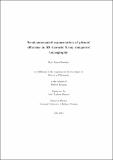| dc.contributor.advisor | Shearer, Andrew | |
| dc.contributor.author | Donohue, Rory James | |
| dc.date.accessioned | 2014-10-09T08:26:07Z | |
| dc.date.available | 2014-10-09T08:26:07Z | |
| dc.date.issued | 2014-09-27 | |
| dc.identifier.uri | http://hdl.handle.net/10379/4630 | |
| dc.description.abstract | A pleural effusion is excess fluid that collects in the pleural cavity, the fluid-filled space that surrounds the lungs. Surplus amounts of such fluid can impair breathing by limiting the expansion of the lungs during inhalation and can cause severe chest pain. Measuring the fluid volume is indicative of the effectiveness of any treatment but, due to the similarity to surrounding regions, fragments of collapsed lung present and topological changes; accurate quantification of the effusion volume is a highly challenging imaging problem. A novel technique is presented that segments the structures of the inner thoracic cage, fits 2D closed curves to the detected pleural cavity features and propagates the curves transversely. Missing structure is interpolated using adjacent slices and orthogonal planes to correctly approximate the pleura. An adaptive slice-by-slice region growth procedure constrained by the bounding curves then extracts the pleural fluid volume. The applicability of the technique is analysed on two concurrent test samples totalling 35 pleural effusion patients. A strong correlation was observed between the pleural fluid volume obtained computationally and manually by a radiologist (R^2 = 0.94). The mean pleural fluid volume for the semi-automated approach was 482.54 mL (±518.32 mL) compared with 485.9 mL (±532.8 mL) for the manual segmentation. The difference was not statistically significant (Student t-test, p = 0.98). The mean overlap of the segmented pleural fluid was 82% (±10%) across all datasets, with a false positive rate of 22% (±11%). The mean duration of the semi-automated segmentation with user interaction was 3.3 minutes (±0.9 minutes) compared with 7.1 minutes (±4.1 minutes) for the manual segmentation. Compared with the current literature, this is an acceptable segmentation result with a considerably lower mean execution time and thus takes a significant step towards a clinically usable pleural effusion segmentation system. | en_US |
| dc.rights | Attribution-NonCommercial-NoDerivs 3.0 Ireland | |
| dc.rights.uri | https://creativecommons.org/licenses/by-nc-nd/3.0/ie/ | |
| dc.subject | Pleural effusion | en_US |
| dc.subject | Thoracic segmentation | en_US |
| dc.subject | Computational tomography | en_US |
| dc.subject | Image segmentation | en_US |
| dc.subject | Medical image processing | en_US |
| dc.subject | Medical imaging | en_US |
| dc.subject | Physics | en_US |
| dc.title | Semi-automated segmentation of pleural effusions in 3D thoracic X-ray computed tomography | en_US |
| dc.type | Thesis | en_US |
| dc.contributor.funder | IRCSET | en_US |
| dc.local.note | A pleural effusion is excess fluid that collects in the pleural cavity, the fluid-filled space that surrounds the lungs. The subject of this work was to develop an image processing pipeline that could segment and quantify the pleural effusion volume in CT images. Radiologists can then use this volume measurement to accurately ascertain the effectiveness of treatment to the patient. | en_US |
| dc.local.final | Yes | en_US |
| nui.item.downloads | 171 | |


